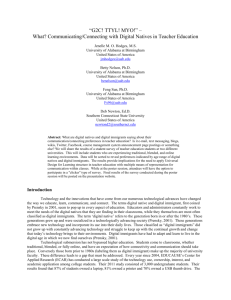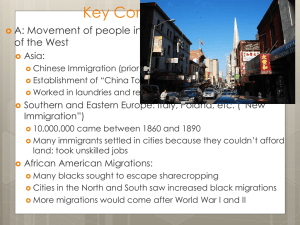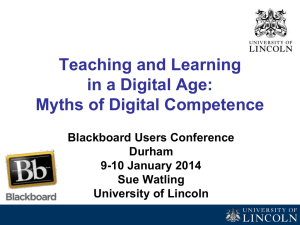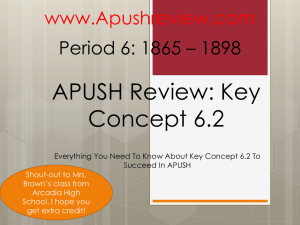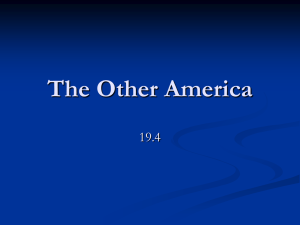Ronald Berman, Ed.D, Grand Canyon University College of Doctoral
advertisement
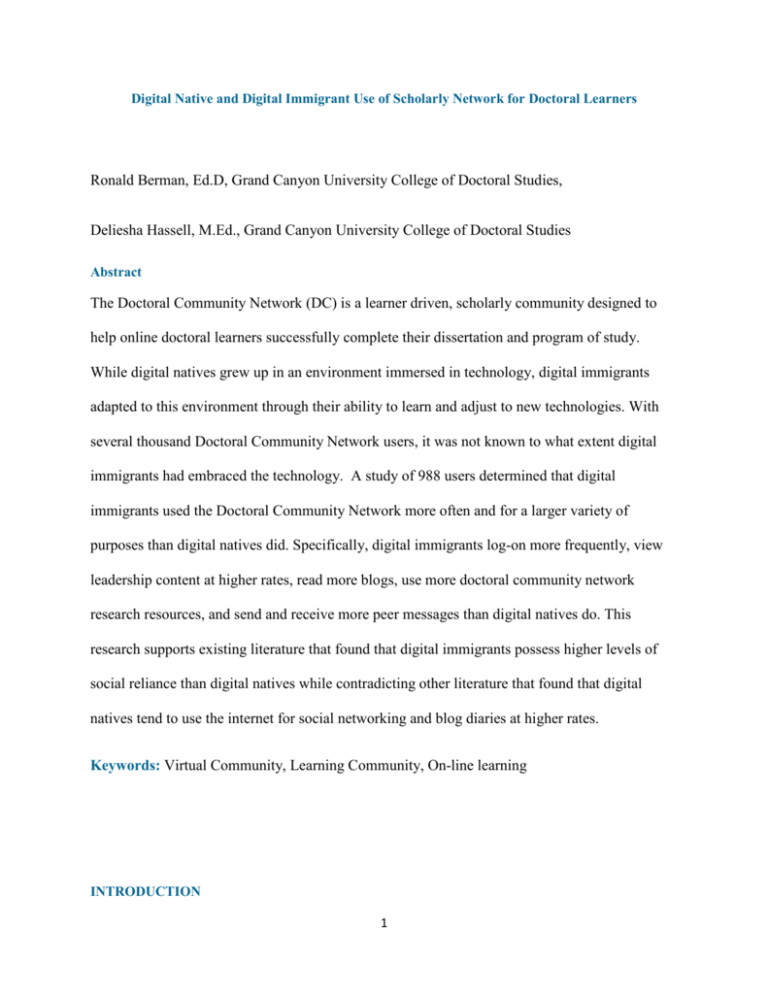
Digital Native and Digital Immigrant Use of Scholarly Network for Doctoral Learners Ronald Berman, Ed.D, Grand Canyon University College of Doctoral Studies, Deliesha Hassell, M.Ed., Grand Canyon University College of Doctoral Studies Abstract The Doctoral Community Network (DC) is a learner driven, scholarly community designed to help online doctoral learners successfully complete their dissertation and program of study. While digital natives grew up in an environment immersed in technology, digital immigrants adapted to this environment through their ability to learn and adjust to new technologies. With several thousand Doctoral Community Network users, it was not known to what extent digital immigrants had embraced the technology. A study of 988 users determined that digital immigrants used the Doctoral Community Network more often and for a larger variety of purposes than digital natives did. Specifically, digital immigrants log-on more frequently, view leadership content at higher rates, read more blogs, use more doctoral community network research resources, and send and receive more peer messages than digital natives do. This research supports existing literature that found that digital immigrants possess higher levels of social reliance than digital natives while contradicting other literature that found that digital natives tend to use the internet for social networking and blog diaries at higher rates. Keywords: Virtual Community, Learning Community, On-line learning INTRODUCTION 1 Doctoral Community Network The Doctoral Community Network (DC) is a learner driven, scholarly community designed to help online doctoral learners successfully complete their dissertation and program of study. In a single virtual location, DC provides a comprehensive catalog of support services to guide and assist new researchers as they learn the process, terminology, tools, and norms to become independent scholars, capable of producing high-quality research. Learner access is provided to timely content written by experts in the fields of quantitative research, qualitative research, and learning technology with an emphasis on leadership in higher education, K-12, psychology, and business. To enhance the creation of scholarly writing, a doctoral writing specialist creates writing short-cuts, and even provides one-on-one tutoring. Using a collaborative technology, DC provides a mechanism for new researchers to receive feedback on prospective research ideas from the entire research community. Once posted on-line, other learners, faculty, and the fulltime doctoral librarian provide feedback, suggestions, and references. Higher education has evolved throughout history to reflect the needs of the society in which it serves. One recent paradigm shift was technology inclusion into the classroom as well the ability for students to enroll in technology-based online courses. With the addition of online education, higher education institutions have witnessed an increased diversification of the student body (Boss & Lowther, 1993). The flexibility of such programs has created opportunities for nontraditional aged students that hold full-time jobs and have families to enroll in higher education courses on a full-time basis without complete interruption of other responsibilities (Blau & Daymont, 2011). As a result, multiple generations are learning together, enrolling in the same programs, and utilizing the same technologies to support and foster their learning. 2 However, educators are finding generational differences in postsecondary students (Borges, N. J., Elam, C. L., Jones, B. J., & Manuel, R., 2010). Prensky (2001a) coined the members of the generational gap as either digital natives or digital immigrants and attributes generational differences to technology immersion. Definitions Certain words will have a specific definition for the purposes of this study. Digital Natives- Individuals, born after 1980, who grew up immersed in technology and as a result possess a high level of confidence and familiarity when using technology (Prensky, 2001a) Digital Immigrants- Individuals, born before 1980, who grew up in a world without technology and as a result lack confidence and familiarity when using technology (Prensky, 2001a) Digital Natives It is important to first develop a general understanding of the existing literature that describes the demographic of digital natives as a whole as well as characteristics exuded by this generation. Throughout history, scholars have identified generations to describe similar characteristics that occur within people because of the similar environment that people are raised in. Prensky (2001a) explained that digital natives consist of any person born after 1980 and digital immigrants consist of any person born before 1980. However, Ransdell, Kent, Gaillard-Kenney, and Long (2011) identified the generations considered as digital natives as Generation Y (born 1992-2001) and the Millennial Generation (born 1982-1991). Clearly, the cut off year of digital 3 natives is under scrutiny but the existing literature agrees on roughly the same year of around 1980. For the purposes of this paper, digital natives will be considered as individuals born after 1980. Currently, digital natives are the age of traditional college students and will continue to be so for several years to come as these generations progress through and graduate from high school. Digital natives make up the generations of current young people that grew up in an environment where they were immersed in digital technology from a young age (Prensky. 2001a, b). Because of this immersion from an early age, these generations naturally possess a high aptitude to learn and adapt to new technologies. Scholars have debated whether academia should assume that age solely defines the digital native as Prensky (2001a) suggested. Helsper & Eynon (2010) designed a study to test this theory. The authors examined the extent in which generation, experience using the internet, and breadth of internet use could be indicators of whether an individual was a digital native or not. By using the Oxford Internet Survey, the authors surveyed 2,350 participants from the ages of 14 to 65 plus and categorized participants into generations that began at nine-year intervals. The survey identified which participants had internet access, how the participants gained that access, how often participants used the internet, and why the internet was used. Helsper & Eynon (2010) determined the younger generations were more likely to be digital natives since they possessed more experience with technology. The authors drew this conclusion since younger participants claimed to use the internet more often than more mature ages participants and had easier access to technology including internet access, which decreased with each nine-year interval generation. 4 Younger people also used the internet more often for social networking, blog diaries, and entertainment whereas the older participants outside of the digital native age range tended to use the internet for fact checking and training (Helsper & Eynon, 2010). The authors discovered that one’s generation was only one factor in determining whether one was a digital native alongside gender, education, experience, and breadth of use. In some aspects, since younger individuals spent more time utilizing technology, this study supported Prensky’s (2001a) theory although the study also pointed out the possibility that aspects other than age may influence whether one is a digital native (Helsper & Eynon, 2010). This opens possibilities for digital immigrants to close the technical knowledge gap and gain the knowledge owned by digital natives through experience and increased breadth of use of technology. Digital natives also “speak their own language” that is native to technology and they perform tasks in a manner where technology comes first (Prensky, 2001a). For example, digital natives search the internet first when in need of information and digital natives expect that technology programs will teach the user to properly use the program as opposed to feeling the need to read a printed manual (Prensky, 2001a). As a result, digital natives are more self-sufficient and selfreliant when it comes to education, since they have been brought up in world where an endless amount of information is a quick search away. Digital natives have spent more time with technology than earlier generations (Dobson et al., 2008) and because of this time, Prensky (2001b) explained that digital natives’ brains have changed due to the exposure of technology. His argument was that technology created new thought processes among digital natives that thrived on instant gratification, frequent rewards, and multitasking. However, more recent empirical studies determined that digital natives’ brains have not physiologically evolved with 5 the introduction of technology but simply reacted to the changed environment as the brain has always been wired to do (Medina, 2009; Small,2008). When one considers Prensky’s theory, one may witness the need to allow digital natives, as learners, to engage in active learning strategies that incorporate their digital native knowledge, which reflects recent changes in society. It is important to note that digital natives, as a whole, are not a homogeneous group but a diverse group with a diverse range of technology experience, preferences, and knowledge (Kennedy, Judd, Dalgarno, & Waycott, 2010). For example, Kennedy et al. (2010) surveyed 2,588 first year higher education digital natives and found a wide range of experience utilizing technology. The first group identified were the “power users” (14%) who displayed a wide range of technology use and use broad technology often, “ordinary users” (27%) who were regular users of the internet and mobile devices, “irregular users” (14%) who engage in internet and mobile devices less frequently, and “basic users” (45%) who use new and emerging technology less than one time per week. Furthermore, a study by Kvavik (2005) of 4,374 digital natives determined that a majority of students owned their own personal computers (93.4%) as well as cellular phones (82%) and a minority of students owned handheld computers (11.9%). Furthermore, a majority of the participants regularly used word processing tools (99.5%), electronic mail (99.5%), and surfed the internet (99.5%) while a minority of students created their own multimedia for the internet (21%). This last finding is significantly lower than what the overarching view of digital natives would possess if all digital natives used technology as Prensky (2001a) had suggested. Jones and Hosein (2010) also surveyed first year university digital natives use of technology and were able to group the participants into a “web-interactive” cluster that possessed high web 2.0 6 knowledge, a “work-oriented” cluster that possessed high work-type software including Microsoft Word and Excel, a “social-interactive” cluster that displayed high levels of instant messaging and social networking site experience, and a “technical-oriented” cluster that had high gaming knowledge. As such, one can conclude that digital natives bring with them different knowledge and interests in the use of a broad technology spectrum. These types of contradictory findings fuel the digital native debate occurring among educational scholars. Bennett and Maton (2010) explained this digital native debate as a belief by many educators that technological changes require immediate new approaches and practices to educate children in order to meet the new digital natives’ changing needs while other educators question whether the digital native technology experience carries over to the educational sector. Younger learners choose to do many different things with technology and often times Web 2.0 tools such as blogs and wikis are the minority creating a contradiction in the claims made that digital natives must be able to express their creativity in order to learn (Bennett, Maton, & Kervin, 2010). Wood, Barnes, Vivian, Scutter, & Stokes-Thompson (2010) found that 99.1% of digital natives enrolled in a higher education program had a Facebook account and that only 20.9% of participants said they would welcome an educational social networking site through their university, 42.1% claimed they would maybe welcome the idea, and 31.5% claimed they would not welcome the idea. This finding is informative in terms of digital native interest in using modern day technologies in the educational setting. Scholars agree that digital natives have increased levels of technology experience over digital immigrants. However, the debate occurs when scholars note that all digital natives do not 7 necessarily possess increased levels of technical knowledge over digital immigrants that allow digital natives to more easily engage with others through technology in online programs (Bennett & Maton, 2010). Those digital natives who choose to use technology for gaming or the development of spreadsheets will not possess the same engagement abilities as those who associate technology with instant messaging and social networking. In other words, digital natives bring with them to school their own experience with technology which ranges according to background, interest, and choices. Digital Immigrants The theory of digital immigrants came to fruition when Prensky (2001a) attempted to describe the generations of people that did not grow up with technology immersed in their lives. Much like the inconsistency that exists among the digital natives, some questions exist about when the digital immigrant generation begins; suggested by Prensky (2001a) as 1982 as opposed to 1980 by Ransdell et al. (2011). For the purposes of this paper, digital immigrants will be considered as individuals born before the year 1980. Prensky (2001a) coined the term digital immigrant as a representation of individuals transplanted into an environment filled with technology, which differs from the environment surrounding digital immigrants throughout their upbringing. Since digital immigrants did not grow up with the daily use of technology as digital natives have, they must often times learn to use the technology that digital natives may already know or can learn at a quicker pace than digital immigrants because of their increased familiarity. Digital immigrants can “speak the same language” as digital natives but often times speak with an “accent” when they refer to actions that limit the use of technology such as printing a 8 document to edit rather than editing the document virtually (Prensky, 2001a). This accent varies in thickness according to the level of technological knowledge (Todelo, 2007). Much like digital natives’ diverse knowledge of technology, digital immigrants also possess a vast array of abilities using technology (Toledo, 2007). For example, some digital immigrants use technology only when absolutely necessary and others keep up with modern technological advances (Ransdell, et al., 2011). Scholars are beginning to categorize the diversity of digital immigrants to address the vastness of technical knowledge within these individuals. “Digital tourists” are those digital immigrants who use technology only when necessary and “digital refugees” are those who use technology on a regular basis (Galliard-Kenney et al., 2011; Toledo, 2007). Despite Prensky’s (2001b) suggestion that digital immigrants could not gain the knowledge owned by digital natives because of a difference in brain function, Helsper and Eynon (2010) found that digital immigrants can obtain the knowledge that digital natives possess and close the generational gap with time and technology experience. This is a result of age only accounting for one characteristic of a digital native. Helsper and Eynon (2010) in contrast to the claims made by Prensky (2001a). Although digital immigrants, as a whole, claimed less confidence in the use of technology than digital natives, they were able to apply what they learned about technology better than digital natives (Ransdell, et al., 2011). As a result, there is a bit of a debate on whether digital immigrants who learn technology as well as digital natives become true digital natives or are placed into a different category such as digital refugees. Furthermore, when one considers online higher education, digital immigrants have increased levels of social reliance when working with technology over digital natives, which has caused digital immigrants to experience increased levels of academic success in online environments 9 (Ransdell, et al., 2011). Social reliance is the belief by an individual that one’s success is dependent upon, in part, interacting with others (Nitsch, 2003). This social reliance is in contrast to digital natives’ increased emphasis in self-reliance, which is a belief that one’s success is based upon one’s own abilities (Nitsch, 2003). By surveying 100 participants, half of which were digital natives and the other half being digital immigrants, Ransdell, et al. (2011) determined that digital immigrants reported lower levels of self-reliance and higher levels of social-reliance resulting in more frequent peer interactions than digital natives. As a result, digital immigrants used their peers as tools much more often than digital natives, which increased levels of digital immigrant student success. Nontraditional 21st Century Doctoral Learners Many leaders of Doctorate of Education (Ed.D) programs are responding to the demands of the modern workforce and taking advantage of technological advances in educational technology to create online doctoral programs (Radda, 2012). Since many nontraditional Ed.D learners are working on this achievement in addition to holding a full time job, the design of these programs need to provide the flexibility necessary to be successful at the doctoral level but also provide the sense of community necessary to socially integrate learners (Radda, 2012). Doctoral learners that choose to take a different route than the traditional face-to-face approach are considered to be nontraditional doctoral learners (Archibald, 2011). Nontraditional doctoral learning is typically designed for learners with 15-25 years of professional experience and virtual learning communities are designed to allow a space for learners to synthesize their own experiences through scholarly engagement (Radda, 2012). Furthermore, with this extensive professional experience comes age, enhancing the chance that nontraditional doctoral leaners are digital immigrants (Archibald, 2011). Aside from classroom discussions and a cohort design system, 10 some higher education institutions are beginning to integrate a scholarly virtual learning community into their doctoral programs to offer doctoral learners this opportunity to share expertise and collaborate outside of the classroom setting. This process also yields doctoral learners the opportunity to develop a scholarly community through social integration. The existing literature explains that a divide exists between digital natives and digital immigrants although the distinction may not be as clear as Prensky (2001a) originally noted. Digital natives grew up in an environment immersed in technology, which was nonexistent in the early lives of digital immigrants. As a result, digital natives tend to have more experience using technology than digital immigrants and have adapted to this environment by increasing their levels of independence through their ability to learn and adjust to new technologies. This phenomenon has yielded an increased breadth of use, familiarity, and confidence among digital natives over digital immigrants while using technology. However, this familiarity of technology is not uniform among all digital natives. Some digital natives use technology that may not translate into the classroom such as gaming or data entry. As a result, digital natives do not enter the classroom as a uniform group of learners but as individuals with individual levels of familiarity with different types of technology. Since the term digital native is more synonymous with experience of technology, the closing of the divide between digital natives and digital immigrants can occur with increased experience and diversification of use by digital immigrants. It appears that most of the advantage owned by digital natives in the digital world is because of a complex system of familiarity reinforced by technology infused classrooms and supplemental tools to support learning. This infusion is being 11 carried into the higher education courses, especially online courses, where instructors ask digital immigrants to operate the tools on an equal level to that of digital natives. It is unknown to what extent digital immigrants use these tools in comparison to digital natives. Research Questions The literature review indicates that age is not the sole factor in determining whether an individual is a digital native or digital immigrant. Existing literature determined that experience using technology, breadth of use, and familiarity were also influential factors that determined digital native and digital immigrant status. The existing literature also noted that digital natives possess higher levels of independence and digital immigrants possess higher levels of social reliance when using technology. When considering GCU’s virtual doctoral community, it is not known to what extent age is a factor that determines usage within the community when comparing digital natives and digital immigrants. Therefore, the following research questions are being proposed: R1 Do Ed.D doctoral learners who are between 20 and 30 years old logon to the Doctoral Community Network more frequently on a weekly basis than Ed.D doctoral students who are between 40 and 70 years old? R2 Do Ed.D doctoral students who are between 20 and 30 cite different reasons for using the doctoral community network as compared to Ed.D doctoral students who are between 40 and 70 years old? R3 Do Ed.D doctoral students who are between 20 and 30 view leadership content on the doctoral community network at higher rates than other Ed.D doctoral students who are between 40 and 70 years old? 12 R4 Do Ed.D doctoral students who are between 20 and 30 view technology content on the doctoral community network at higher rates than other Ed.D doctoral students who are between 40 and 70 years old? R5 Do Ed.D doctoral students who are between 20 and 30 years old indicate that the doctoral community network enhances their doctoral experience at higher rates than other Ed.D doctoral students who are between 40 and 70 years old? METHODOLOGY Data Collection Leaders of the College of Doctoral Studies designed an anonymous 16 question survey that contained a combination of dichotomous, semantic differential, cumulative, and open-ended questions delivered in an online format. Each question focused on one of four categories regarding the virtual community. The categories collected (1) demographic information of each participant including the participants’ dissertation stage, program of study, age in 10-year spans, virtual community usage frequency, and gender, (2) reasons for participant use of the virtual community as well as questions about content within the virtual community, (3) levels of connection felt by participants to other learners, faculty members, the College of Doctoral Studies, and the program of study influenced by the virtual community, and (4) overall feelings associated with the virtual community including the ability of the virtual community to enhance the doctoral experience as well as satisfaction of the virtual community. The opportunity for participants to complete the survey occurred during a required classroom session of the online doctoral program’s face-to-face residency. The residency occurred at a hotel near the university’s 13 main campus during June and July of 2012 that focused on development of students’ dissertations. Sample The population under study included 988 students enrolled in an online doctoral program at a private university located in the southwest United States. Of the 988 doctoral students, 848 participants responded to a survey yielding a response rate of 85.8%. Each participant held a master’s degree and was at the pre-dissertation phase in their doctoral program of study. As the scope of this study was focused on the Doctor of Education program, responses from students enrolled in the Doctor of Business Administration and Doctor of Philosophy programs were removed. In addition, the researchers eliminated students in their 30’s since both digital natives and digital immigrants concurrently fell into this age range. The researchers also removed students that preferred not to report their age (which may have included learners 70 years or older). After removing these respondents, 546 participants remained. The final sample consisted of 41 digital natives in their 20’s and 505 digital immigrants in their 40’s, 50’s, and 60’s. Data Analysis Once the researchers collected the data, the researchers filtered the data in a way that applied to the needed sample by excluding respondents outside of the Ed.D program, respondents in their 30’s, and respondents that chose not to disclose their age. The researchers then categorized each answer choice made by the respondents to the survey questions according to the respondent’s respective ages, 20’s, 40’s, 50’s, and 60’s. This way, the researchers could create percentages for each answer choice chosen by the respondent in each age range in order to compare digital natives and digital immigrants. The design of the survey questions included in this study allowed 14 the sample to choose answers that they felt best applied to them. As such, the frequency that the answer choices were chosen were then turned into percentages according to each respondent’s age. In order to compare the answers of digital natives and digital immigrants for the purposes of this study, respondents in their 20’s were considered as the sole age range to represent digital natives, so their percentage for each answer choice represented the percentage for digital natives. Furthermore, the sample of digital immigrants consisted of individuals in their 40’s, 50’s, and 60’s, so the researchers took the absolute mean percentage of these sample groups’ answer choices for each question of the survey to identify the percentage of each answer choice. However, in the results section, the percentages are shown in both this format and the individual percentages per decade age range. The researchers carried out this data analysis process to answer each of the five research questions. For the first research question, question number four of the survey was analyzed. For research question number two, survey question number seven was analyzed. For research questions three and four, survey question number 11 was analyzed and for the final research question, survey question 15 was analyzed. Limitations University leaders conducted the online survey during a face-to-face residency session of a majority online program. During the survey, participants were removed from their familiar online environment and placed into a setting where they were physically surrounded by faculty and staff members as well as other students enrolled in the doctoral program. As a result, a possible limitation of this study was that participants may have felt increased levels of 15 connection during the time of the survey administration than they would in more familiar circumstances. In addition, the survey relied on student perceptions including their reasons for use and usage frequency of the virtual community. Participants may have not felt comfortable acknowledging their true use and usage frequency in the presence of university faculty and staff, which could have hindered the results of this study. Finally, an imbalance existed in the sample between the representation of digital natives (n = 41) and digital immigrants (n =505). Results Usage Frequency The results of the survey indicate that digital natives do not log-on more frequently to the Doctoral Community Network than digital immigrants do. According to the survey, 42% of digital natives log-on to the network each week as compared to 55% of digital immigrants. More specifically, 64% of students in their 40s, 61% of students in their 50’s, and 59% of students in their 50s log on to the network each week. However, when examining weekly usage frequency, more digital natives indicate that they log-on only once per week than digital immigrants. When the usage frequency is increased to two, three, or four times per week digital immigrants indicate that they log-on up to 100% more than digital natives creating high usage frequency among digital immigrants, as shown in the diagram below (Figure 1). 16 Figure 1. Usage Frequency of the DCN 70 60 50 40 4+ times per week 30 2 - 3 times per week 1 time per week 20 10 0 20s 40 50 60 Usage of the Doctoral Community Network Digital natives do cite some different reasons for using the doctoral community than digital immigrants do. Digital natives post a dissertation topic much more often than digital immigrants (DN= 70.7%, DI= 59.3%). However, digital immigrants read more blogs (DN=22%, DI=44.3%), use more doctoral community network research resources (DN= 39%, DI= 52.3%), and send and receive more peer messages (DN=17.1%, DI=27%) than digital immigrants do, as displayed in the graph below. 17 Figure 2. Usage of the DCN 80 70 Post a dissertation Topic 60 50 Read a Blog 40 Dissertation Research 30 20 Send/Receive peer messages 10 0 20s 40s 50s 60s Leadership and Technology Content Digital natives do not view content on leadership at higher rates than digital immigrants do. The sample consisted solely of learners in the Ed.D Organizational Leadership program and as a result, the findings of this study assist in the determination of whether learners use the Doctoral Community Network to locate content specifically geared towards the learners’ degree of organizational leadership. Digital natives responded with a significantly lower percentage than digital immigrants did when asked if they viewed content regarding leadership on the network (DN= 20%, DI= 36.9%). Furthermore, digital natives do not view content on technology at higher rates than digital immigrants. Digital natives also responded with significantly lower percentage when asked if they viewed content regarding technology on the Doctoral Community Network (DN= 5%, DI= 14.3%), as displayed in the chart below. 18 Figure 3. Leadership and Technology Content 50 45 40 35 30 Viewed Content on Technology 25 20 Viewed Content on Leadership 15 10 5 0 20s 40s 50s 60s Doctoral Community Network Enhancement of Doctoral Experience Digital natives do not indicate that the Doctoral Community Network enhanced their doctoral experience at higher rates than digital immigrants do. It does appear that digital immigrants indicated slightly increased levels of an enhanced doctoral experience due to the Doctoral Community Network, however when asked to what extent the network enhanced their experience digital immigrants indicated significantly higher percentages of responses to “a great extent” than digital natives did (DN= 22%, DI=35.3%). Furthermore, a higher percentage of digital natives indicate that the doctoral community network enhanced their doctoral experience to some extent (DN= 48.8%, 41.1%), as displayed in the chart below. 19 Figure 4. Enhancement of the Doctoral Experience Because of the DCN 90 80 70 60 50 To some extent 40 To a great extent 30 20 10 0 20s 40 50 60 Discussion This study determined that digital immigrants used the doctoral community network more often and for a larger variety of purposes than digital natives did. This research confirmed some of the existing literature regarding digital natives and digital immigrants. For example, Ransdell, et al. (2011) claimed that digital immigrants possessed higher levels of social reliance than digital natives did. In this study, digital immigrants sent and received significantly more peer messages and read more blogs than digital natives did. The increased social interaction among digital immigrants over digital natives suggests that digital immigrants are more social reliant when compared to digital immigrants. Furthermore, digital immigrants also viewed significantly more technology content than digital natives did. Perhaps this occurred because of the digital immigrants’ unfamiliarity with technology that stems from of their digital immigrant status, as the existing literature suggested. 20 However, this study also yielded some results that contradicted the existing literature on digital natives and digital immigrants. Helpser and Eynon (2010) found that digital natives tended to use the internet for social networking and blog diaries at higher rates. Although the doctoral community is not a social networking site, it does support networking in a scholarly form. However, this study found that digital immigrants used these features at higher rates than digital natives did. In addition, because of digital natives’ familiarity with technology, the existing literature suggested that digital natives should be able to learn and use the doctoral network at higher rates than digital immigrants. However, this study determined that digital immigrants logged on more frequently each week than digital natives did and that digital immigrants claimed that the doctoral community network enhanced their doctoral journey to higher extents than digital natives did. Both of these findings are in contrast to the existing literature regarding digital natives but are in favor of the ideology surrounding digital immigrant social reliance and may have occurred as a result of digital native diverse knowledge of technology not translating into the usage of the virtual learning community. This foundational study opens the door to future research about online scholarly networks similar to the doctoral community network. While this study examined variables by age, one can expand upon this study by determining to what extent a learner’s age affect learners’ likelihood to contribute information to the network. In addition, determining why digital immigrants loggedon more frequently to the doctoral community network could assist in the development of these networks by creating an understanding what digital immigrants’ value within the network. This future study could further encourage the use of the network of the most frequent users, the digital immigrants. Furthermore, determining why digital natives use the network less frequently than 21 digital immigrants could assist leaders in filling these voids to make the network more useful for digital natives. Another topic needing further research is to determine why digital immigrants sent and received more messages to peers via the doctoral community network than to other students, which supports the existing literature. In addition, determining whether usage frequency of the doctoral community network contributes to doctoral learners’ level of connectedness, academic performance, and overall program satisfaction would contribute to the existing body of knowledge about online scholarly networks. Finally, taking into account the diversity of technical knowledge that digital natives and digital immigrants possess, additional studies should be initiated that detail digital native and immigrant use of virtual communities such as the DC Network. Furthermore, acknowledging the increased levels of social reliance found in digital immigrants (Ransdell, et al., 2011) an additional study may be conducted to assess the effects that the integration of video conferencing in the DC Network has on digital natives’ and digital immigrants’ levels of satisfaction and levels of isolation felt by online doctoral learners (Radda, 2012). As higher education continues to add online programs, it becomes important to recognize the different levels of technical knowledge possessed of all learners, including both digital natives and digital immigrants. As these learners enroll in online higher education programs, educational leaders cannot assume that digital natives will be prepared to engage with others through the use of technology nor should educational leaders assume that digital immigrants would rather limit their technology use to communicate with peers. 22 CONCLUSION The extant literature regarding digital natives and digital immigrants made clear that individuals within these divides vary greatly in their technical interest and abilities. As a result, this topic appears to be much more complex than Prensky (2001a) originally noted based solely on age. When considering a scholarly learning community, whose goal is to socially integrate online learners, the extant literature would suggest that usage of the community would differ greatly due to the increased levels familiarity possessed by digital natives and the increased levels of social reliance held by digital immigrants. This would lead to assumptions that digital natives would use the network more often due to increased familiarity using technology but also that digital immigrants may use the network more often to satisfy their social reliance. Within the DC Network, digital immigrants relied more heavily on contact with peers through messages and blogs and viewed more content on technology, which would support the existing literature. However, counterintuitive to the some extant literature, digital immigrants used the virtual learning community more often than digital natives despite the ideas about digital natives using technology more frequently than digital immigrants. One may suggest that this is due to digital natives’ increased self-reliance and their belief that they may not need the support of others to be successful in their doctoral program in contrast to beliefs of digital immigrants. 23 REFERENCES Archbald, D. (2011). The emergence of the nontraditional doctorate: A historical overview. New Directions for Adult and Continuing Education, (129), 7-19. Bennett, S., &, K. Maton (2010). Beyond the digital natives debate: Towards a more nuanced understanding of students' technology experiences. Journal of Computer Assisted Learning, 26(5), 321-331. Bennett, S., Maton, K., & Kervin, L. (2008). The ‘digital natives’ debate: A critical review of the evidence. British Journal Of Educational Technology, 39(5), 775-786. doi:10.1111/j.1467-8535.2007.00793.x. Blau, G., & Daymont, T. (2011). Deciding between traditional and online formats: Exploring the role of learning advantages, flexibility, and compensatory adaptation. Journal of Behavioral & Applied Management, 12(2), 156-175. Borges, N. J., Elam, C. L., Jones, B. J., & Manuel, R., (2010). Differences in motives between Millennial and Generation X medical students. Medical Education, 44(6), 570-576. doi:10.1111/j.1365-2923.2010.03633.x Boss, M. A. & Lowther, M.A. (1993). Factors influencing curriculum change in professional programs. ASHE Annual Meeting Paper. Dobson, T., Guo, R., & Petrina, S. (2008). Digital natives, digital immigrants: An analysis of age and ICT competency in teacher education. Journal of Educational Computing Research, 38(3), 235-254. 24 Helsper, E. & Eynon, R. (2010). Digital natives: Where is the evidence? British Educational Research Journal, 36(3), 503-520. doi:10.1080/01411920902989227 Jones, C., & Hosein, A. (2010). Profiling university students' use of technology: Where is the net generation divide? International Journal of Technology, Knowledge & Society, 6(3), 4358. Kennedy, G. G., Judd, T. T., Dalgarno, B. B., & Waycott, J. J. (2010). Beyond natives and immigrants: Exploring types of net generation students. Journal of Computer Assisted Learning, 26(5), 332-343. doi:10.1111/j.1365-2729.2010.00371. Kvavik, R.B. (2005). Convenience, communication, and control: How students use technology. Educating the Net Generation. p. 7.1-7.20. Boulder, CO: EDUCAUSE. Medina, John (2009). Brain Rules: 12 Principles for Surviving and Thriving at Work, Home, and School. Seattle, WA: Pear Press. Nitsch, W. B. (2003). Examination of factors leading to student retention in online graduate education. Retrieved from http://www.decadeconsulting.com/decade/papers/StudentRetention.pdf Prensky, M. (2001a). Digital natives, digital immigrants part one. On the Horizon, 9(1), 1-6. Retrieved from http://www.marcprensky.com/writing/Prensky%20%20Digital%20Natives,%20Digital%20Immigrants%20-%20Part1.pdf. Prensky, M. (2001b). Digital natives, digital immigrants part two: Do they really think differently? On the Horizon 9(6): 1-6. Retrieved from 25 http://www.marcprensky.com/writing/Prensky%20%20Digital%20Natives,%20Digital%20Immigrants%20-%20Part2.pdf. Radda, H. (2012). From theory to practice to experience: Building scholarly learning communities in nontraditional doctoral programs. Insight: A Journal of Scholarly Teaching, 750-53. Ransdell, S., Kent, B., Gaillard-Kenney, S., & Long, J. (2011). Digital immigrants fare better than digital natives due to social reliance. British Journal of Educational Technology, 42(6), 931-938. doi:10.1111/j.1467-8535.2010.01137.x Small, G. (2009). Your brain on google: Patterns of cerebral activation during internet searching. American Journal of Geriatric Psychiatry. 17(2): 116-126.8/7455. Toledo, C. A. (2007). Digital culture: Immigrants and tourists responding to the natives' drumbeat. International Journal of Teaching & Learning in Higher Education, 19(1), 8492. Wood, D., Barnes, A., Vivian, R., Scutter, S., & Stokes-Thompson, F. (2010). The future may have arrived, but engagement with ICTs is not equal among our diverse "net gen" learners. In C. H. Steel, M. J. Keppell, P. Gerbic & S. Housego (Eds.), Curriculum, technology & transformation for an unknown future. Proceedings ascilite Sydney 2010 (pp. 1107-1118). http://ascilite.org.au/conferences/sydney10/procs/Wood2-full.pdf 26
